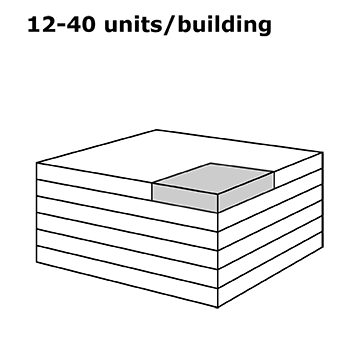
People have always sought shelter from the weather, from predators, and other dangers. From living in caves, people created all different types of homes from wigwams, tipis, tent houses, yurts, adobe houses, stone houses, blockhouses, brick houses, ice igloos, log cabins, wooden houses, boathouses, stilt houses, and many more innovative types. People built expediently using local materials and construction techniques. Early structures accommodated single spaces for almost all living purposes, pushing bathrooms and cooking areas outside to protect the interior from smells or fires. People accrued wealth and built additional rooms defined to specific activities like sleeping in bedrooms and living in principal rooms. The Dutch were the first to bring the kitchen into the house with safer cooking practices making it a domestic workspace. Houses expanded to provide for extended and multigenerational families. As villages grow into towns and towns into cities, houses built side by became row houses, townhomes, and housing blocks. With more substantial materials and structural systems, taller buildings diversify the housing stock lowrise apartments, medium-rise, and highrise apartments and condos. In cities, the range of houses varies from individual to low, medium, and high rise. Often, older homes’ heritage and building stock are torn down and replaced with larger, denser housings structures. With more than half of the world’s population of 9 billion people migrating to cities for opportunities, architects will build more housing structures.
Activity 1 – SROs & Studio Apartments
Single Residency Occupancies are small efficiency units for people with low income or homeless individuals. They can be as little as 80sf to 140 square feet, even smaller than today’s Tiny Homes. Originally many SROs came furnished with a bed, chair, and desk; SROs today may also contain a sink, small refrigerator, and microwave. SROS today also sometimes share bathrooms and kitchens, especially in Cooperative housing complexes. They also can vary in size to a large as 300 or 400sf approaching Studio Apartments. Millions of SROS have been repurposed into condominiums, creating a lack of affordable housing opportunities. If cities are to be places of potential for all, a wider variety of housing opportunities are needed.
Activity 2 – single family

Single homes rented or purchased by individuals, couples, or families occupy one third to one half-acre lots in the city and one to five acres lots or more in the suburbs and countryside of the United States. Single-family homes come in many styles. See the Housing Style Journey to see some common types. Single-family homes can be one to three stories tall and come in many variations. Three Story homes sometimes are Work/Live models with a store, office, or workshop on the ground floor and living space above. Single-family homes in the United States have grown from 1800sf in the 1950s to an average of 2400sf today. Single-family homes in the United States usually have a living room, kitchen, maybe a dining room, a den or family or great room, bedrooms, and bathrooms. Homes include spaces that support human activities such as eating, washing, recreating, working, and sleeping. Real estate information of homes consists of the location, school district, square footage of space, acreage of the lot, number of bedrooms, number of bathrooms, overall square footage of structure and the property, cost per square foot, and information about appliances and heating, cooling and ventilation and local property taxes.
Using Google Earth, draw your single-family home or find a single-family house to draw in your community.
Activity 3 – duplex

Duplexes are two houses that share a central wall or floor. Duplexes may be side by side homes or homes on the first and second floors. Sometimes huge houses are downsized to become two (or more) by adding new kitchens. Rental duplexes are often in a mixed neighborhood of privately owned dwellings. Find side by side and stacked duplexes in your community. Both types are prevalent for singles and beginning families and densify shared living opportunities. Some duplexes are rentals; others are condominium units offered for sale for people looking to purchase residential space. Duplexes come in many styles and arrangements that range from small and medium to large, all offering a kitchen, living/dining rooms, bedrooms, and bathrooms.
Please photograph or sketch a duplex in your city and upload it to the Gallery for Activity 3!
Activity 4 – multiplex

Three or more homes constructed as a single unit with different entrances and living areas is called a multi-plex. These units are either an existing larger house broken into separate living units or new construction that offers front, side, and sometimes back entries to multiple floors. Walk your neighborhood and photograph three different multiplex buildings. Look for main entrances. Take a picture of three multiplex buildings. Try to guess how many people live in each.
Upload your photos to the Gallery for Activity 4.
Activity 5 – Row Houses

Row houses are typical in cities in Europe and the United States. An early example is the speculative row house of the Marais at Place des Vosges. Built-in 1605 as speculative development in a new quarter, homes that share walls and roofs situate around a square park set for jousting and other festivals. A colonnaded first floor offers shops and cafes with housing above. The row house typology became popular in Northern Europe and Britain in the 16th and 17th centuries as residences for the aristocracy and worker housing. Row houses in the Netherlands coincided with kitchens becoming part of the domestic interior with wood-burning stoves. It may come as a surprise that today’s bathrooms are a 20th-century invention.
In the 1900s, a chamber pot and bowl stored in the ‘commode’ area sufficed. Families shared ‘baths’ in tubs in the kitchen or back deck only weekly. The earliest interior plumbing serving porcelain sinks and tubs and toilets began to appear in the 1910s but took until the 1950s for the bathroom to be achievable in all new construction. Row houses are typically 25 or 30 feet wide; windows are only on the front and rear, as the side walls are shared. Some row houses have a walled front or rear garden, and some even have gardens front and back. Parking is on the street, under the buildings, or in shared garage spaces in a front street or parking lot or rear or underground garage. Typical layouts of row houses include an entry with stairs to the second floor, a living/dining room, and a kitchen. Bedrooms usually are on the second floor. Additional rooms such as a den or home office, attic, and basement spaces are sometimes available. Today row houses appear in Baltimore, Boston, New York, Philadelphia, San Francisco, Seattle, and other cities. They are also popular in Canadian cities and Australia, and New Zealand. Look at row houses around the world. Look around your city. Can you find row houses?
Please take a photo or draw them and upload them to the Gallery for activity 5.
Activity 6 – Lowrise Apartment Building

Low rise apartment buildings developed from boarding houses that offered rents when city populations grew faster than the housing market allowed. Boarding houses opened the market to people renting bedrooms and sharing the amenities of a single-family home- the kitchen, living/dining area, and baths. Apartment buildings use land more efficiently than single-family homes, and the lowrise apartment building stacks multiple units on four floors. Residents take stairs or elevators to reach their residences. Low Rise Apartments offer Studio Apartments (one room with a kitchenette and a bathroom) to three bedrooms units. Apartments may offer a ground floor garden, balconies, shared common spaces, exercise rooms, and parking facilities. Washer and Dryers may be in a shared laundry room or individual to each unit. Find an example of a lowrise apartment building in your city.
Take a picture of it or draw it and post it to the Gallery Activity 6.
Activity 7 – Midrise Housing

As fire safety protection developed, sprinklered buildings could be taller than four floors. Midrise apartment buildings between five and fifteen stories developed. As demand for housing continued, apartments got taller. Some apartment rentals converted to condominiums with individually purchased units that pay a monthly condominium fee for building maintenance. Midrise Apartment/condominium buildings are popular and cost-efficient, usually within walking distance of stores, and offer amenities like balconies, parking, in-apartment laundry, etc. The larger buildings have multiple elevators, sometimes splitting the lobbies into multiple entries and wrapping around an internal courtyard. Midrise facilities are also popular in transit hubs where people live in the suburbs and access transportation into cities.
Find examples of midrise apartment buildings and share the photos writing a short commentary about which one you might like to live in and why.
Activity 8 – Taller Midrise Housing Blocks

As population and the demand for housing increases, midrise buildings are torn down and replaced by high rise apartment buildings. Living higher in the sky becomes possible with the invention of structural steel framing, improvements of elevators, fire protection, and HVAC (Heating, cooling, and ventilating systems), and most importantly, the elevator. During the 20th century, urban housing towers rose rapidly taller after World War II, culminating in the 21st century’s tallest residential tower on Central Park in New York City topping off at ? stories. The cost and size of residences increase the higher up in the sky. Tall skyscraper living becomes prestigious and for the ultra-wealthy. While city skylines sparkle and get taller and taller, others question the quality of life in tall buildings as one’s full-time residence. Towers offer outdoor public terraces at several levels, outdoor gardens, roof decks, swimming pools, exercise rooms, delicatessens, cafes, business centers, community rooms, and more!
Activity 9 – mid rise housing

Activity 10 – High-Rise Housing

Review
Explore
- Altgeld Gardens Mastrplan
- Average Home Size per State
- BKL Housing Towers
- Britannica Apartment House
- Central Park's Nordstrom's World's Tallest Residential Tower
- Getty Images Boston Row Houses
- Habitat for Humanity
- Habitat Qinhuangdao
- Henley Hale Brown Stirling Prize Winners
- High-Rise High Density Harvard ISSUU
- House Stories
- HOUSING CRISIS World Population
- KONING EISENBERG
- Landon Bone Baker Architects
- London Row Houses
- Midrise Multi Family Housing
- Missing Middle Housing Website
- National Building Museum Making Room for Housing
- NYC Skyscraper Museum From Tenements to Towers
- Place Des Vosges Townhomes
- Primer on Missing Middle Housing Report
- Proctor & Shaw London
- Psychological Effects of High Rise Living Editorial
- Queensbridge Housing NYC
- Renée Gailhoustet Paris Housing
- Renée Gailhoustet Social Housing Architect
- Row Houses Amsterdam
- Row (Terraced) Housing around the World
- Safdie Habitat in Nature Video
- Sanchis Olivares Spain
- San Francisco Row Houses
- Saudi Arabia's Line Housing
- Skyscraper Museum High-RISE High Density Density
- Skyscraper Museum Tenement Crowding
- Smith/GIL Housing Towers
- Tatiano Bilboa Estudio Mexico
- The 20th Century Bathroom
- The New York Row House Then and Now
- The Wave Housing Vejle, Denmark
- UK Housing that Defined the 20th Century
- Why are America's Houses so Big?
- Why cities need mid size housing
- Why Did Pruitt Igoe Fail?
- WORLD Housing During Covid Brings Data of Living Arrangements
- World's Tallest Housing High-rises












































